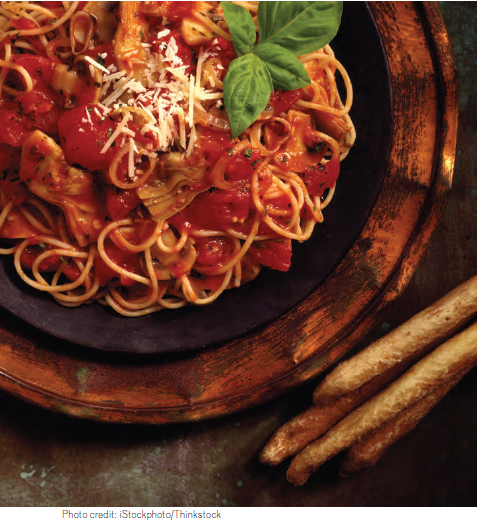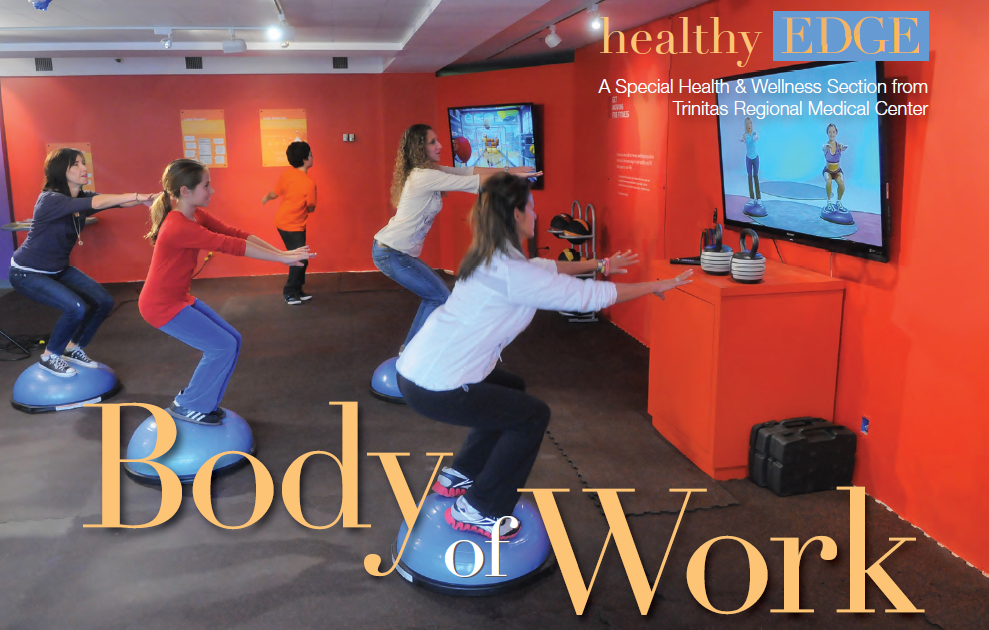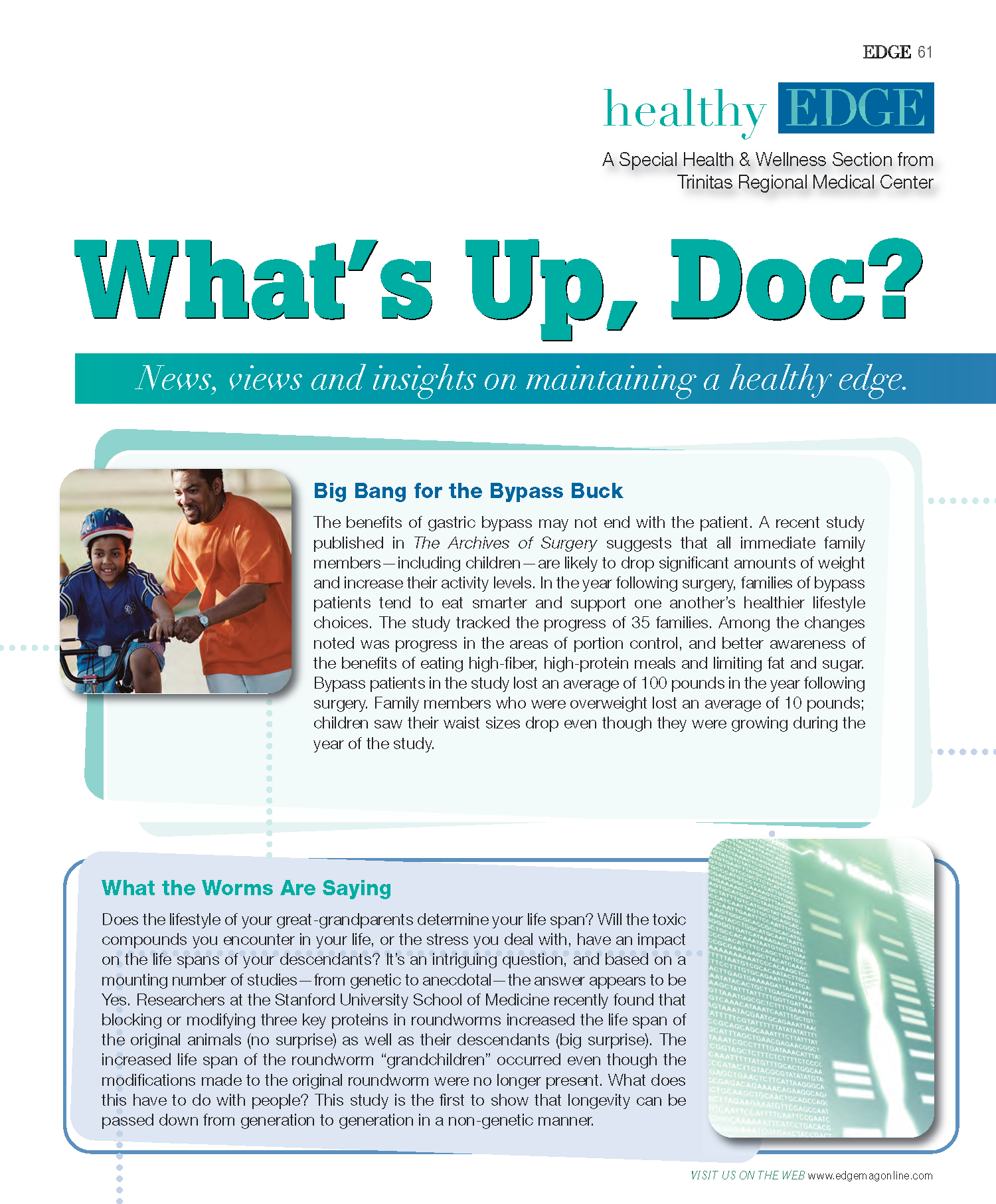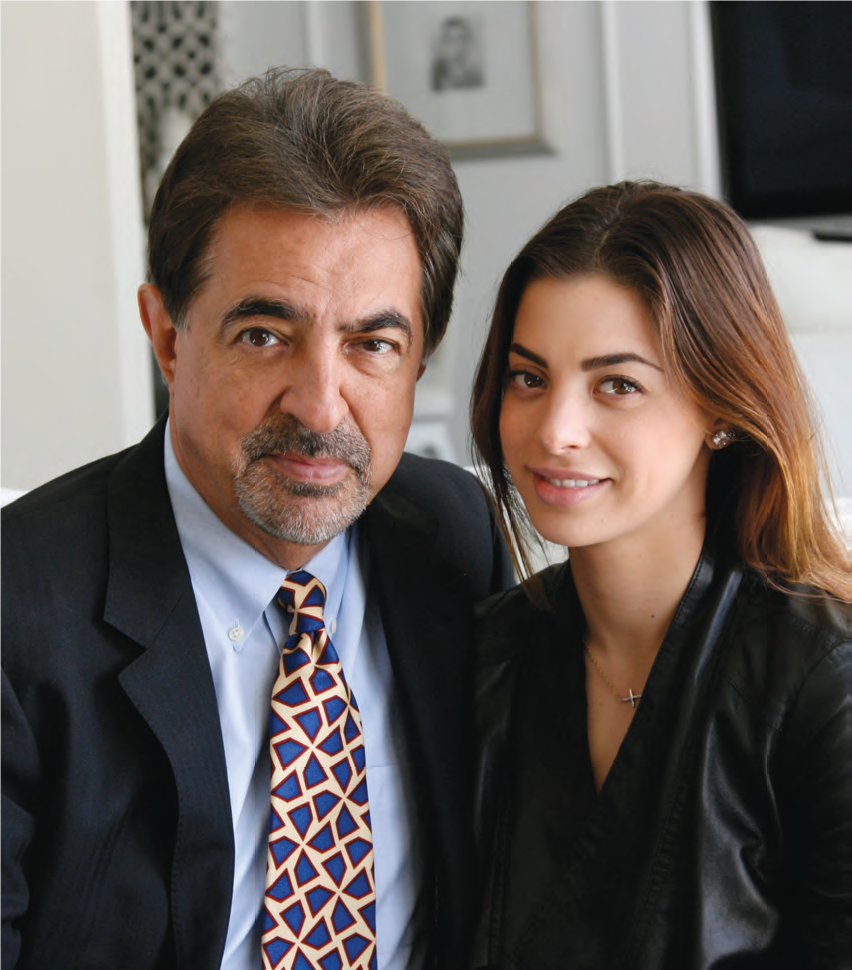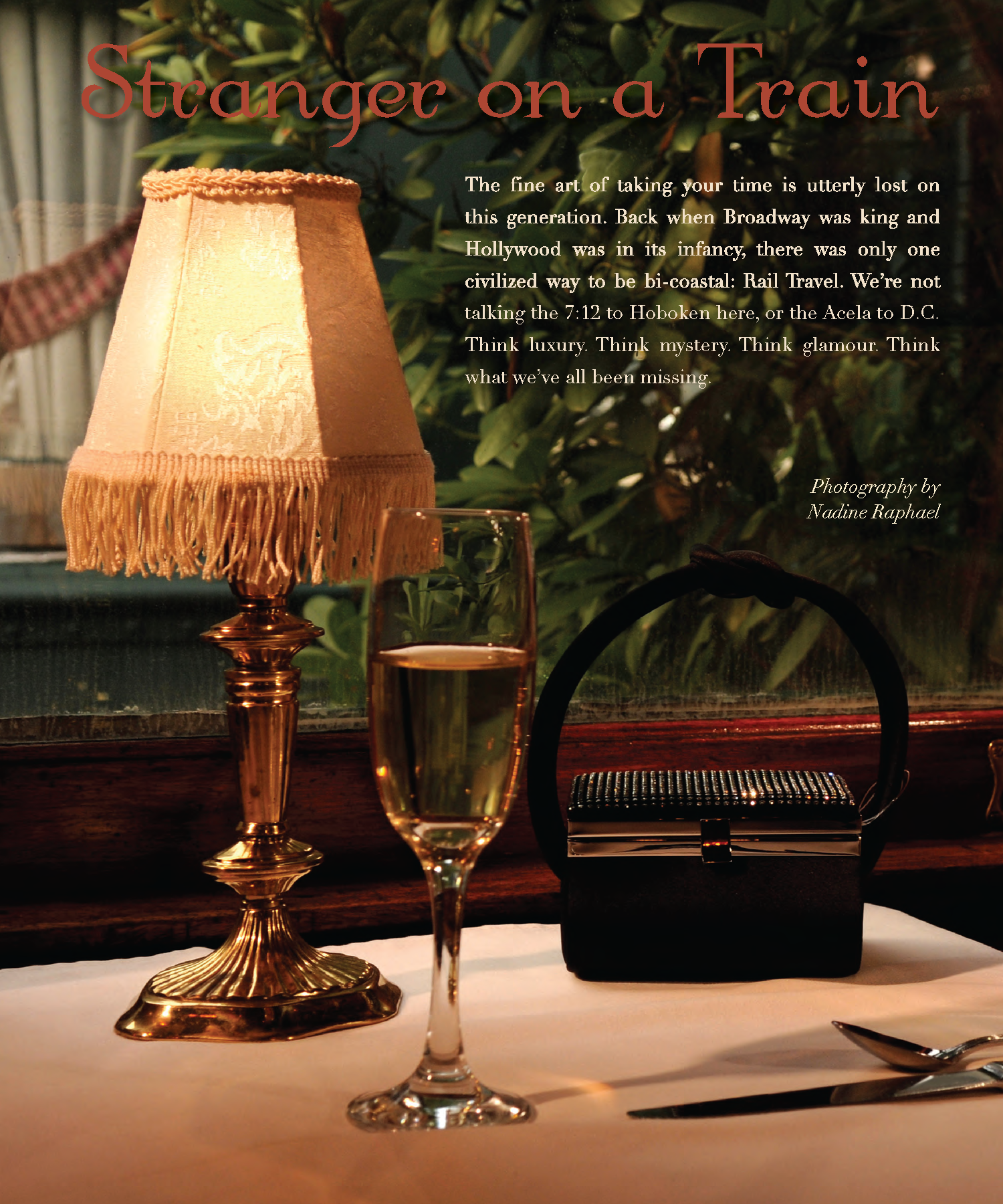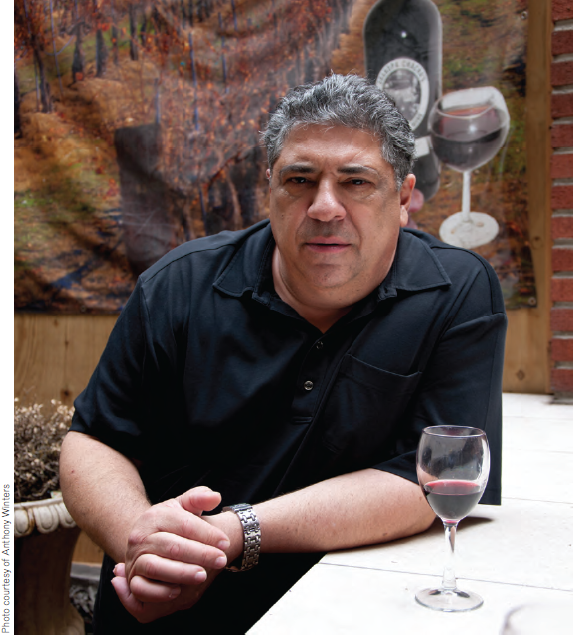‘The ricotta-marinara blush sauce is crazy-good, its rich cheesey soul tempered by the acidity of tomatoes. Get it over a sturdy pasta that can stand up to the sauce.’
Should you be worried you’ve actually come to the right place, the voice – The Voice – of Frank Sinatra will reassure you that you have, that this duck-your head, watch-your-step, below-sea-level entrance is indeed the way, the only way, to enter the inner sanctum of Chef Vola’s. Frank is always singing at Chef Vola’s.  Frank, who legend has it wanted to be buried with a slice of owner Louise Esposito’s banana cream pie, who knew the secret behind the name of the world-renowned restaurant, and who just might be its unofficial mascot, invariably greets diners who descend into the basement and keeps crooning all night long. Those diners might be Jay-Z and Beyonce. They might be members of the cast of The Sopranos. They might be sports stars. They might be good old Jersey boy rock stars such as Jon Bon Jovi. You don’t believe these folks, plus heads of state and of Fortune 500 companies, hurdle the hoops of the reservation process to score a table in the cramped, cluttered, completely charismatic low-ceilinged, dimly lit dining spaces where vintage Italian nonna fare is served alongside a handful of improbable-sounding original Esposito dishes? They do.
Frank, who legend has it wanted to be buried with a slice of owner Louise Esposito’s banana cream pie, who knew the secret behind the name of the world-renowned restaurant, and who just might be its unofficial mascot, invariably greets diners who descend into the basement and keeps crooning all night long. Those diners might be Jay-Z and Beyonce. They might be members of the cast of The Sopranos. They might be sports stars. They might be good old Jersey boy rock stars such as Jon Bon Jovi. You don’t believe these folks, plus heads of state and of Fortune 500 companies, hurdle the hoops of the reservation process to score a table in the cramped, cluttered, completely charismatic low-ceilinged, dimly lit dining spaces where vintage Italian nonna fare is served alongside a handful of improbable-sounding original Esposito dishes? They do.
Check out Chef Vola’s walls of fame that bulge with bumper-to-bumper photos of Louise and her co-owner family members, husband Michael and sons Michael Jr. and Louis, as they snuggle with the familiar faces of those they’ve fed. Fancy-pants restaurants can’t claim the extent of the celebrity patronage of this 90-year-old BYOB a block from the Boardwalk and at the edge of a neighborhood sometimes described as a tad sketchy in Atlantic City. They fly in from L.A. They pit-stop from a finals match to a championship game. They hop-scotch from Munich via Philadelphia, renting a car and driving east on the Atlantic City Expressway. As did my dining neighbors the same night I marveled at the new additions to my old restaurant friend, which had gotten a bathroom upgrade and some extra seating since my last visit. (Oh, don’t think Chef Vola’s still isn’t cheek-to-jowl. You will, I promise, still be able to read the fine print on the wine bottles at the adjoining table and hear everything said.)
Two couples from Germany started their U.S. tour with a dinner at Chef Vola’s because, they revealed, friends who’d made a similar trek told them the food, the atmosphere—and what I translated as schtick—was the best anywhere. And you only have to drive from your home port somewhere in New Jersey. Chances are, once you do, you will again. You may well make reservations on your way out for your next birthday or anniversary. You will return for the cannellini and string bean salad scattered with cubes of sharp cheese and salami, a veal chop so large you will be glad you didn’t fly in because even the leftovers couldn’t fit in an airplane’s overhead compartment, pasta awash in a “blush” sauce that combines ricotta and marinara, and Louise Esposito’s pies, each of which—and there are a good couple dozen—have their own ardent legions of fans. I’ll throw my support behind the coconut-pecan ricotta pie, but we’ll discuss later. First, the hype surrounding Chef Vola’s is exaggerated. Yes, the phone number remains unlisted in a phone-book sense of listing numbers. But you have it here and you can find it if you have basic-level Internet skills. Second, you can get a reservation. As with many extremely popular restaurants, you simply have to plan ahead, call ahead and not expect a table at 8 on a Saturday night.
didn’t fly in because even the leftovers couldn’t fit in an airplane’s overhead compartment, pasta awash in a “blush” sauce that combines ricotta and marinara, and Louise Esposito’s pies, each of which—and there are a good couple dozen—have their own ardent legions of fans. I’ll throw my support behind the coconut-pecan ricotta pie, but we’ll discuss later. First, the hype surrounding Chef Vola’s is exaggerated. Yes, the phone number remains unlisted in a phone-book sense of listing numbers. But you have it here and you can find it if you have basic-level Internet skills. Second, you can get a reservation. As with many extremely popular restaurants, you simply have to plan ahead, call ahead and not expect a table at 8 on a Saturday night.
You don’t need to be blood relatives of the Espositos or routinely play to sold-out concerts in stadiums. Yes, it’s cash only, it’s not cheap and you must bring your own spirits. (Consider prosecco for starters and a red wine for entrées.) It is a bit hard to find on initial visit. Park in the lot in the shadow of the Tropicana and walk a block and a half north. That boardinghouse-style structure you see at an odd, almost dead end is Chef Vola’s. Don’t look up for the entrance, but look down and to the side farthest from the Atlantic Ocean. You got it, Bunky. Now you’ve got to get a salad, such as that double-bean number with creamy white cannellinis and crisp green-bean batons set off by the same elements as a classic chopped salad. Or, right for autumn, the toss of arugula with dabs of goat cheese, sweet-tart dried cranberries and a dressing much like a fig glaze, only thinner. Don’t go all hoggish on the plates delivered to your table: Share everything.
Chef Vola’s is where the you-getta-lot school of eating in Joisey was born. You’ll find prosciutto- and roasted red pepper-wrapped mozzarella served to half the diners around you. You’ll see crab cakes made from jumbo lump crab that defy the genre in pure size of lump. They’re simple and divine. Too many people, distracted by the sensationalism of the crab cakes, overlook the most rustic of dishes here, the veal sausages. Please don’t make this mistake. Channel your inner Italian grandma and get these links with their tangle of fried red and green peppers and onions. The second you’ll walk in the door, you’ll get a hankering for pasta, and you should not let this craving go unabated. The ricotta-marinara blush sauce I spoke of is crazy-good, its rich cheesey soul tempered by the acidity of tomatoes. Get it over a sturdy pasta that can stand up to the sauce. Or, if you’re choice-challenged, try the pasta trio.
The night of my recent visit, we blasted angel hair with that blush sauce and took another haystack of the thin macaroni with a clam sauce skillfully composed of clams, a jigger of olive oil and plenty of garlic. I adored the mushroom fra diavolo, a chunky sauce with spirit and sass, though I think I’ll like it better next time with penne. I so liked the Flintstone-size veal chop with mushrooms I once had at a birthday dinner that I maneuvered ordering to make sure my first-timer dining companions could take a stab at it. To my knowledge, they are still debating which rendition of the veal chop they most love: the mushroom’d one or the parm’d one. (Parm fans outnumber ‘shroom fans a good 10-to-1. I’m a proud minority voice.) While my companions argued, I ate most of a fish entrée I’d avoided at previous dinners because it sounded unlikable. It’s anything but, no matter how overwrought it sounds: red snapper topped with a jumbo lump crab cake and topped again with a Champagne-Cognac cream sauce, all of which is swirled with pesto. Who knew this could work? The Espositos, who invented it.
If you want to delve into Chef Vola’s history, and perhaps be told the secret behind its name, order the chicken cacciatore. It’s one of the few dishes from the original owner of the restaurant, Chef Pina Vola. And here’s what few patrons know: Pina Vola was a woman. (She sold the place to a fellow who kept it fairly intact until 1982, when the Espositos bought it and greatly expanded the menu.) Not only weren’t there many female chefs in Pina’s day, women weren’t exactly thought of as top chef material. Which maybe is why Pina didn’t do much to publicize her presence. But her cacciatore is commendable, a feisty stew that lets big-flavored tomatoes dominate. Do order it bone-in. And don’t fold on me now, not with your nimble server ready to recite the pies of the night. Plus, Frank’s probably revved up to “New York, New York” form and one of those Espositos will be watching, if not taking your dessert order personally.
If you want to get invited back – that is, have your next reservation taken—don’t skip dessert. With Sinatra’s devotion to the banana cream pie recommendation enough (be aware it comes semi-frozen, which I think doesn’t do its flavor justice—but who am I and what do I know?), I’ll direct you to the coconut-pecan ricotta pie. It’s served warm and it’s a doozy, the shreds of coconut and crumbles of pecan bringing soul to the molten cheese. I’ve also got a thing for the limoncello cream pie. This one’s packed into a crust made of lemon drop cookies, which are the perfect foil for the pumped-up Italian liqueur. Decadence is what the chocolate-peanut butter mousse pie is about. I laughed as I watched a friend tuck away all but the three bites I’d taken mere minutes after declaring himself too full to make it back to the car, let alone consider dessert. Maybe that’s why Louise Esposito personally slaves over those pies. Maybe that’s why this family and its crews both in the kitchen and in the front of the house shimmy around the diminutive spaces night after night. They want to keep an eye on you to make sure you’ve taken dinner to the extreme—eaten more than you should, laughed more than usual, eavesdropped on your table neighbors more than propriety allows. They want you to have the full Chef Vola’s experience. Their way.
There are no second acts when it comes to throwing a football party. Here’s how to get it right the first time.
The mid-winter football party. Call it a tradition. Call it a cliché. Call it what you want, but don’t call me if the menu features burgers, dogs and slaw. As a former running back and linebacker, I’m telling you that you must respect the game. And that means you must respect the food you serve during the game. Long after the final whistle blows, and the X’s and O’s are a distant memory, you want your friends and family to still be talking about your culinary playbook. Some basic guidelines. Have your guests come an hour before kickoff. Prepare everything in small, individual portions. This makes eating neater and increases the likelihood that people will take home the leftovers. Assign a different “buffet coach” for each quarter. You’ll be moving food in and out of the game like Tom Landry, so it’s important to have an extra set of eyes, ears and hands to help you—and someone to keep the buffet area clean. Finally, print out a lineup of the food you plan to serve, and when it’s scheduled to appear. Think of it as a game day program. It helps people pace themselves and gauge how much to eat.
PREGAME I love it when I walk through the door at a football party and see something totally unexpected. Caviar, eggs Benedict, pastramied salmon—something that tells me this party is going to be fun. It’s like running a double-reverse or a wildcat on the first play of the game. The crowd starts buzzing and the defense is thrown back on its heels. I love that. You can really get the party going with a pancake bar. Bet you’ve never seen one of these. Set up a griddle, a container of batter, and various fillings and toppings. Everything from pieces of fresh fruit to shreds of Peking duck. People love making pancakes. They take five minutes and bring out the kid in us. And it’s really fun if you have kids at the party. Everyone will improvise. Some people will use them like soft tacos. It’s a wonderful way to get people to start interacting with the food, and one another, as they arrive.
FIRST QUARTER As people settle in for the start of the game, bring the big time finger food out to the buffet. By that I mean items you can eat with your hands. Food fumbles can ruin a party, and I think people make a way bigger mess trying to eat with a knife and fork on a couch than they do eating with their hands and a couple of napkins. Traditionally, this is where you might be tempted to serve burgers and dogs. If you do, I’m throwing the penalty flag. Instead of hamburgers, I’d suggest meatloaf. Find a recipe you like, make tiny, individual football-shaped sliders and serve them on rolls. They only take 15 or 20 minutes to cook, and they come right out of the oven hot, like fresh baked cookies. I serve them in my restaurants and people love them. If you must have dogs, then think about serving chorizos, or doing franks in a blanket. But if it’s simply a pork product you’re craving, why not go with BLTs? Use double-cut bacon, and heirloom tomatoes if you can find them. You could also add some guacamole. Who doesn’t love making themselves a BLT? By the way, a great hot side dish for a football party is tater tots. Buy them in a bag and doctor them up a little. They go great smashed into the BLTs, and the leftover ones are good for food fights.
SECOND QUARTER You’ve heard of an option play? Well, your option here is chili. This is one of the things you can cook the day before and it only gets better. Serve it with chips in little copper-pot bowls lined with tortillas. Amazing! Everyone has his or her own take on chili. Personally, I think most are too sweet. Use lots of meat and a little sauce, almost like a Bolognese. The meat should have some texture. You want your chili to have heartiness, and you get that with the right combination of acid, salt, sweet and a sense of heat. I also add puréed bell peppers. The fat should come from the sour cream or cheese. I’m not a bean guy, unless it’s vegetarian chili. If you must, offer beans on the side as a mix-in.
HALFTIME This is where you can get a second use out of the pancake griddle. Clean it off during the first half, keep it warm, and then fire it up for people to make the ultimate grilled cheese sandwich. Buy a bunch of different varieties and let people experiment. If you’ve opted for BLTs in the first half, make sure to set aside a few slabs of bacon and sliced tomatoes. Football parties aren’t about super-healthy eating, but it’s a nice idea to offer a salad. I would go with something more manageable and interesting than lettuce. Think about a bean salad. Mix great northern white beans, black-eyed peas, green beans cooked until they’re not too crunchy, chopped tomatoes, garlic, basil and olive oil. You can break this out at halftime, too.
THIRD QUARTER A championship football team comes out of the locker room at halftime with a game-changing plan that’s full of surprises. The third quarter means it’s time for kebabs! This is another item you can assemble in advance. They are fun to make the night before. Marinate the completed skewers and keep them refrigerated until game time, when they go under the broiler on the grill while the marching bands take the field. The kebabs don’t have to be huge, and the way to serve them is inside a tortilla. Squeeze the tortilla and pull. You have a great little fajita.
FOURTH QUARTER Pizza. Seriously. Toward the end of the third quarter, get your oven good and hot and start making little individual pies. Use the leftovers from the first-half spread—cheese, pancake and chili toppings, meatloaf. People can individualize their own mini pies, or you can surprise them. By this time, some of your guests may be groaning, but if they’ve paced themselves they should have room. The added benefit of finishing the game with pizza? There’s less to clean up and put away, and you can send people home with the extra pies. Believe me, they’ll take them.
TWO-MINUTE DRILL But wait. The final two minutes is crunch time, right? That means dessert—something totally underrated at football parties. This is your opportunity to roll out the team colors. We’re not talking cupcakes here. Cupcakes are a rookie mistake. They are time-consuming to make, a pain to eat, and you’re never really happy with the way they turn out. Think fresh fruit. Giants fan? Raspberries, strawberries and blueberries over vanilla ice cream. Jets fan? Use grapes, kiwis and Granny Smiths. Steelers fan? That could be a problem. If you have black fruit in the house you’ve probably killed your guests already. By the way, the grownup version of this dessert is spectacular. Pre-scoop the ice cream into clear glasses the night before (with team logos, of course). Heat up the fruit in a pan with a little OJ and marmalade, sugar, sweet wine or brandy, and throw in a cinnamon stick. Add the fruit to the ice cream, shake on some powdered sugar and bingo— you’ve hit pay dirt!
Editor’s Note: David Burke owns Fromagerie in Rumson, Primehouse in Chicago, Prime in Connecticut, and Fishtail, David Burke Townhouse, and David Burke Kitchen at the James Hotel in Manhattan.
Transforming an imperfect space into something usable and new is easier than you think. Just pray you pick the right architect.

Opening page: The historic Chapel at Ft. Hancock on Sandy Hook. It was poorly illuminated; the beautiful trusses and ceiling boards were hidden in shadows. I upgraded the lighting and electrical, converted side rooms into bathrooms, reopenend the boarded-up balcony, and now it can accommodate weddings and other large functions.
The scenario is a painfully familiar one. House-hunters pass on what they think is a train wreck, only to discover a year or two later that someone else scooped it up for a song and transformed it into a showplace. Old homes are full of exciting potential, but can also be petrifying. Whether you are renovating before you move in, or tackling them on a project-by-project basis after you’ve taken up residence, it’s hard not to think about Tom Hanks’s excruciating slide into The Money Pit. Right actor. Wrong film.
In Sleepless in Seattle, Hanks actually provided the correct blueprint for a major home renovation. His architect, Sam, had the ideal relationship with the homeowner. That job was going to turn out beautifully. I should know. As an architect who specializes in repurposing historic spaces, I’ve lived both movies. In Sleepless, architect and client had an ongoing dialogue, which also included the contractor (played by Rob Reiner). Issues were openly discussed and strong decisions were made. This is the type of situation that inspires a positive relationship, with the kind of mutual respect that delivers the confidence needed to move forward and make the transformation happen. Which is a roundabout way of saying that, before you trust your instincts and make a potentially life-altering financial decision about a great old space, you need to talk to an architect. We are in touch with the pulse of trends and issues that affect every aspect of a renovation. When brought on board early, we can help clarify the challenges, discuss different options, or even assist in the actual selection of a property.
When weighing a decision, particularly with higher values at stake—such as the purchase of a home to be remodeled versus remodeling your own residence—including an experienced architect in the conversation not only gives the process an exciting kick-start, it will probably pay for itself many times over. So, how does one start? Select a few architects to interview. Ask to see examples of their work and possibly go visit one or two. Have a prepared list of questions that represent your main concerns. Try to engage them in the kind of dialogue that is important to you. After all, you may be entrusting them with the very space where your children will grow up, or that you may retire in. The closer the relationship and bond you develop, the more in-tune your architect will be to your values and beliefs. These all eventually translate into the solution, the look and—most importantly—the feel of the renovation.



Open A Window One good piece of advice I can offer is once you’ve made your choice, gather all the information you’ve been thinking about to share with your architect. I encourage my clients to begin collecting images, articles, books and even physical materials they find appealing. Even if these items involve structures and spaces that are seemingly unrelated, they are extremely helpful. They are the window into your thoughts. The architect’s job is to interpret them. Using these as a starting point, we can develop a vocabulary that relates to, and works with, the existing property—but which might also reference your collection for inspiration to an entirely new and different direction. An early mentor of mine taught me how to engage and enjoy the process, as well as the reward of the product itself. We too often miss this by focusing solely on the budget, schedule and layers of tasks to accomplish. Taking the time to work closely with your architect helps to bring the importance of the function, aesthetic and space itself into view. Have faith in the process. Embrace it with confidence and trust rather than fear. You never know. Your success story could become the plot for the next Tom Hanks movie.
Editor’s Note: Bob Kellner specializes in adaptive reuse and sustainable design. As an architect, his portfolio runs the gamut from large-scale work (including the master plan for Bank of America’s Corporate Headquarters and for Ft. Hancock on Sandy Hook) to major renovations in iconic properties (among them the Waldorf-Astoria and Plaza hotels) to the diversity of more modest commercial interiors. Bob enjoys residential work as a balance to larger-scale projects for the opportunities they present to focus on details, materials and concepts that are more personal. He is the recipient of numerous design awards.
Two years in the making, Generation Fit opens at the Newark Museum.
If you are the parent of a school-age child, then you are undoubtedly aware of the fact that 1) there isn’t much around here in the way of interactive museums once you’ve done the Liberty Science Center, and 2) left to their own devices, kids will almost always make the most atrocious food choices imaginable. (My own still insist Sour Patch Kids count as a serving of fruit). These seemingly unrelated facts are suddenly relevant thanks to the Newark Museum, which is opening an intriguing new exhibit for young people on November 26 entitled Generation Fit: Steps to a Healthier Lifestyle. The name may not be as spine-tingling as a ride at Great Adventure, but rest assured that it’s worth the trip. As the final touches were being put on the colorful and inviting 2,000 square feet of space, Ismael  Calderon, Ed. D—the museum’s Director of Science and curator of Generation Fit—gave EDGE a tantalizing sneak peek. Calderon calls it an exploratory space, and that it is. But here’s the clever part—as kids explore the interactive exhibits, lessons of healthy eating, the benefits of exercise and a profound awareness of their own bodies start to sink in.
Calderon, Ed. D—the museum’s Director of Science and curator of Generation Fit—gave EDGE a tantalizing sneak peek. Calderon calls it an exploratory space, and that it is. But here’s the clever part—as kids explore the interactive exhibits, lessons of healthy eating, the benefits of exercise and a profound awareness of their own bodies start to sink in.
By the time children have worked their way around Generation Fit, they are likely to be a little smarter about the choices they make. According to Calderon, that’s a big step on the path to a healthier lifestyle. “Remember that we have been hard-wired to eat dating back to our days as hunter-gatherers,” he points out. “Today, we do less work to get our food, and much of the food that is available has little nutritional value.” One of the core messages of Generation Fit is that a healthy body is not measured so much by its outward appearance, but rather according to a person’s heart rate, determined by age.
The exhibit focuses on themes related to nutrition and exercise that are designed for families of all shapes and sizes—encouraging conversation in an inviting and non-judgmental environment. Different body types displayed at the entrance convey this message. Incidentally, by the time you reach this point, you’ve already been outfitted with a pedometer and raced up a flight of stairs. No elevators, please! Inside Generation Fit are a series of interrelated sections that engage kids and help simplify complex ideas through interactive displays. In the What is a Calorie? section, kids work the Calorie Crank, which provides a hard lesson in the amount of activity required to burn off a cheeseburger and fries. (Parents will merely appreciate that they don’t have to explain to their children what a calorie is.) One of the coolest teaching tools is the Body Scan. Kids roll a computer screen over a full-sized representation of a human body and it uses the different types of scans doctors employ for an “inside look” at diseases related to being overweight or obese.
You’ll be prying your children away from Body Scan, probably so you can play with it yourself. The My Plate section addresses nutrition and portions in a clever way. An array of foods representing various cultures is set upon a dining table, along with plates ready to be filled. After kids make their picks, an 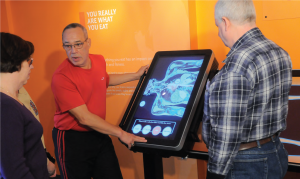 interactive display provides feedback on whether the selected meal is sufficiently balanced. It also provides alternative food choices. As you work your way around the exhibit hall, you’ll encounter the Label Decoder, Sugar Detective, Dollars and Scents, Know Your BMI, Exertainment and FIT Center (FIT is an acronym for frequency, intensity & time). You can probably make an educated guess at what each offers, and you’d be right. The key thing here is that Calderon (left) has seen to it that each section over-delivers. Two good things to know about Generation Fit. First, to avoid the chaos and disorder that sometimes diminish other interactive children’s exhibits, the Newark Museum will probably be time-ticketing the exhibit. This is a great idea. Call ahead to get details on this. Second, the crowded times for Generation Fit will probably be between noon and 2:00 pm. Plan accordingly.
interactive display provides feedback on whether the selected meal is sufficiently balanced. It also provides alternative food choices. As you work your way around the exhibit hall, you’ll encounter the Label Decoder, Sugar Detective, Dollars and Scents, Know Your BMI, Exertainment and FIT Center (FIT is an acronym for frequency, intensity & time). You can probably make an educated guess at what each offers, and you’d be right. The key thing here is that Calderon (left) has seen to it that each section over-delivers. Two good things to know about Generation Fit. First, to avoid the chaos and disorder that sometimes diminish other interactive children’s exhibits, the Newark Museum will probably be time-ticketing the exhibit. This is a great idea. Call ahead to get details on this. Second, the crowded times for Generation Fit will probably be between noon and 2:00 pm. Plan accordingly.
Editor’s Note: The museum is located at 49 Washington Street in the Downtown Arts District, a couple of minutes away from NJPAC, and is open Wednesday thru Sunday from noon to 5:00 pm. Generation Fit uses research data from the Robert Wood Johnson Foundation and Center for Disease Prevention, the national Let’s Move! Initiative, National Institute of Health and scholarly journals.
Addiction is an issue that impacts everyone in some way. To overcome addiction—whether it is your own, a friend’s or a loved one’s—it is crucial to understand what addiction is, how it works, and why it is so easy to fall back into unhealthy habits. Trinitas psychologists Dr. Rodger Goddard and Dr. Patricia Neary-Ludmer discuss the role that “triggers” play in addictive behavior…
Goddard: There are many definitions of addiction including those that are used in a clinical psychiatric setting and those that are used in everyday language and everyday settings. A broad definition of addiction involves things that we consume or do compulsively, that are injurious to our health or happiness, and are very difficult to give up. These can be referred to as health-compromising habits. Health compromising habits may include compulsive shopping, unhealthy eating, overuse of computers or video games, self-doubt, negative emotional states, and so on.
Neary-Ludmer: Another important aspect of addictions— whether we are referring to eating disorders, substance abuse, compulsive behavior or tobacco use—is that they can be viewed as unhealthy coping behaviors. Boredom, anxiety, depression, trauma and failure are just a few of the triggers that might be antecedents to these addictive behaviors. When the unhealthy behavior leads to a reduction in the unwanted feelings, the behavior is reinforced. For example, a high-school student feeling rejected by peers may restrict eating or purge as a way of feeling more in control. Self- destructive cutting behavior also can lead to a reduction in emotional pain. And of course numbing emotional pain through the use of alcohol and drugs is a common pathway to addiction. Problems disappear for the moment, but are still there once the drugs and alcohol wear off.
Goddard: Triggers are the actions, events, people and things that initiate the addictive action. Triggers may become almost as rewarding as the addiction itself—they elicit brain chemistry changes similar to the actual addictive substance or behavior. They trap and lock us into the addiction. For alcoholics, the sound of ice jiggling in a glass, a bottle being opened, or the pouring of wine, beer or gin can heighten the urge for relief from stress by having a drink at the end (or beginning!) of our day.
Neary-Ludmer: How does one avoid or control these triggers? Support groups and therapists will warn the individual to stay away from the people, places and things that may trigger by association a need to drink, use drugs, gamble, smoke, cut or engage in eating disorder behaviors. They must build new friendships, interests and places to go. Obviously, drug addicts can be triggered by being with old buddies they got high with in the past. But they even need to avoid their old haunts, which serve as a reminder of the good times and put them at greater risk to use again.
Goddard: Substituting a new social network can be an important trigger-stopper. This is why Alcoholics Anonymous is so successful at helping alcoholics to overcome their addiction. An alcoholic can now socialize with people who are not popping corks and bottles.
Neary-Ludmer: Also, there may be a stimulus or an event that is so threatening that an addict feels the need to return to unhealthy behaviors. At this point you need someone to call to support you. In AA or Narcotics Anonymous, you have a sponsor to call and meeting you can attend. This is also a good time to have a therapist in place, to help see you through tough times.
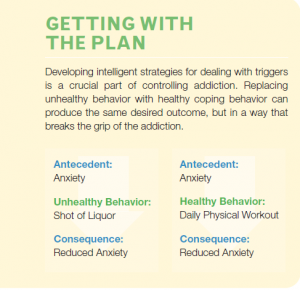 Goddard: The greater our ability to identify a trigger, the stronger we become at overcoming an addiction. Trigger awareness can help us to substitute a behavior that does not injure our health or quality of life. When we can identify our triggers it is possible to stop the negative action before it takes us over. Writing down triggers can be a first step in overcoming addictions. Sometimes we are able to overcome an addiction on our own, but sometimes it is critical to get help from a therapist, clinic or professionals that specialize in addiction.
Goddard: The greater our ability to identify a trigger, the stronger we become at overcoming an addiction. Trigger awareness can help us to substitute a behavior that does not injure our health or quality of life. When we can identify our triggers it is possible to stop the negative action before it takes us over. Writing down triggers can be a first step in overcoming addictions. Sometimes we are able to overcome an addiction on our own, but sometimes it is critical to get help from a therapist, clinic or professionals that specialize in addiction.
Neary-Ludmer: Unfortunately, all triggers are not avoidable. This is why it’s so important for an individual to make that plan…and manage those triggers that simply can’t be predicted or avoided.
Editor’s Note: Dr. Rodger Goddard is Chief Psychologist at Trinitas and Director of the hospital’s wellness program which provides companies, agencies and schools with onsite programs to improve health and productivity. Dr. Patricia Neary-Ludmer manages the Family Resource Center in Cranford, which is affiliated with Trinitas’s Department of Behavioral Health and Psychiatry.


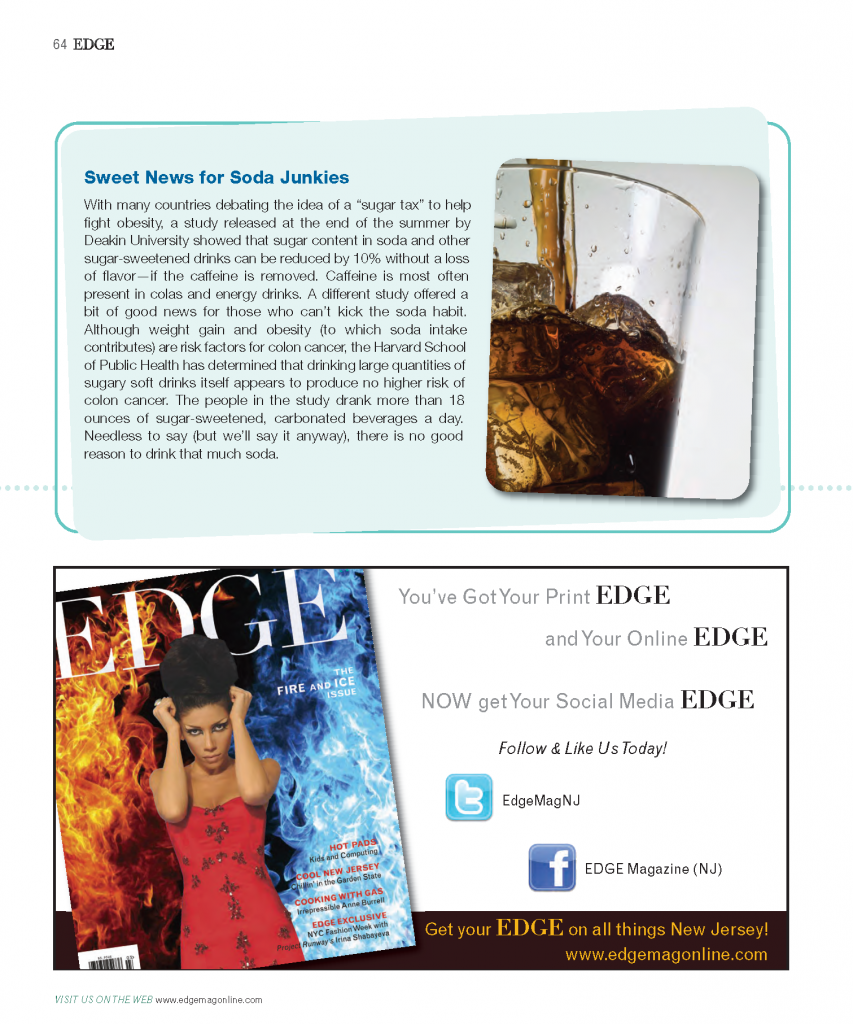
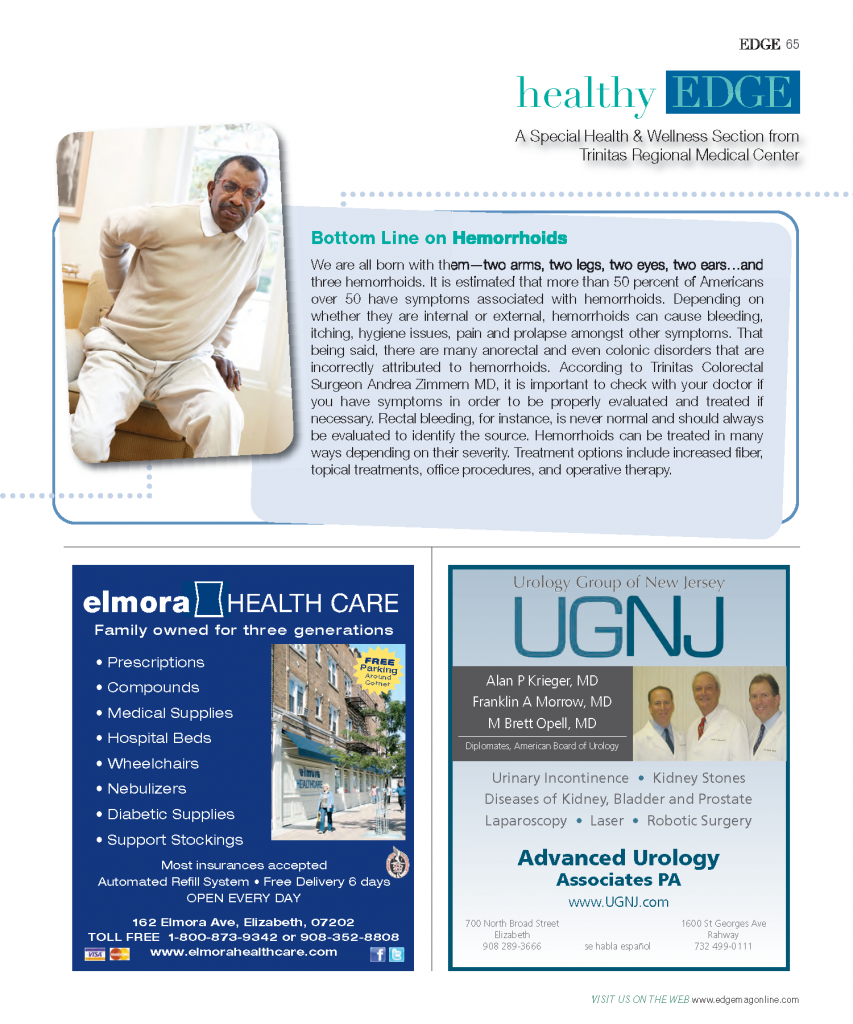
There is no greater joy for a father than seeing his daughter follow him into the family business. Because of the business he’s in, Joe Mantegna is granted the added pleasure of literally watching his daughter, Gia, as she makes a name for herself on stage and screen. Every Hollywood family deals with this dynamic a little differently, of course. Yet as J.M. Stewart discovered during a leisurely meal at Taste of Chicago in Burbank, Joe and Gia handle it particularly well. If you’re one of those people who thinks that acting is an art and parenting is a job, well, this interview may change your mind. For the Mantegnas, it’s clearly the other way around.
EDGE: I would like to start by avoiding the obvious question, which goes something like, ‘Gia, what have you learned about acting from your father…’ (simultaneously)
JM: Everything. (simultaneously)
GM: Nothing. Absolutely nothing.
EDGE: Okay then. Well, in the spirit of avoiding that question, Joe, what have you learned from watching Gia?
JM: Part of what I’ve learned is that what we do is inherent. It’s just there. When I became an actor, I saw the children of actors working and wondered, What’s that about? Would they have even gotten into acting if they weren’t following their parents? I came from a background of no actors, nobody in my family was is show business at all. I thought, This can’t be genetic. It must be one of those things where the kids go, ‘Oh, my dad’s doing it so I’m going to do it.’ But then I’d see Jane and Peter Fonda, and Jeff and Beau Bridges and think, Oh, they’ve got it. As I got more into the business, I started to realize that they’re good because it’s in them. I’ve been around enough actors now to know that you can teach some things, but you’ve either got it or you don’t got it.
EDGE: Like sports.
JM: Right. You can see the kids that have the kind of natural ability they can improve upon. And then there are the kids that, well, it’s not their cup of tea. Gia does have it. I’m not kidding myself because she’s my daughter. I would be the cruelest critic of all if I felt she didn’t have that thing she can build on. I would have told her years ago, ‘I know that you think this is fun and all, but it’s not for you.’ If anything, I have to instill in her not to be like I am, not to be lazy about it.
EDGE: Lazy in what respect?
JM: I found myself thinking, I can do this, I don’t need to work on it that much. I’m not the most driven actor in the world. But I’ve gotten by and made it in spite of that.
EDGE: If you were more driven, how do you think it would have affected your career?
JM: Maybe things would have happened sooner if I had focused more attention on it. Maybe not. I don’t know. But it wasn’t me. I’ve seen other actors do that. Every day they devote twenty-four hours to How can I succeed? I was, like, If it happens, it happens. I never pushed myself to where it infringed on my life, to where I really had to sacrifice something. I enjoyed it, I wanted it to be fun. That’s my approach to a lot of things. I didn’t think, Oh my God, if I don’t make it I’ll die! I was, like, If things don’t work out, I’ll become a forest ranger.
GM: A forest ranger? Really?
JM: In reality, I probably would have been a photographer.
EDGE: Gia, what percentage of your father’s work have you seen?
GM: Five percent. I’ve seen very little because most of it was released when I was too young to watch, or it was R rated. Half the films he dies in and I was too frightened to watch. I remember flipping through the channels watching a movie, and I saw my dad walking down the street with a bouquet of flowers. I went, Yes! Dad’s on TV in something I can watch, this is so cool! A couple of minutes pass and he’s shot down with a machine gun. It affected me much more than I thought it would. I remember seeing Baby’s Day Out when I was four. We thought, Finally he did a movie that the family could watch. We’re sitting on the bed, my sister’s right next to me, and here comes the scene when the baby’s in his pants, lighting his crotch on fire.
JM: Yeah, we’re thinking it’s a great family movie. But I get beaten up by gorillas and blown up. It was a horror film to them.
GM: It was awful. I remember running out of the room crying. And dad’s hitting his face, saying, ‘Look it’s me, I’m okay. I’m here.’ So I never really sat down and watched my dad’s movies, because he was probably going to get the crap kicked out of him.
EDGE: Even now?
GM: Well, I watch Criminal Minds. But I can’t really watch it alone because it’s such a terrifying show.
EDGE: Joe, Gia has been in a couple of movies where she’s strung up and begging for her life—
GM: Apple doesn’t fall far from the tree, I guess.
EDGE: Joe, do you have the same reaction?
JM: I know the process. I’m totally familiar with it. I can disassociate. It’s disturbing, but I know what’s going on.
GM: My mom sometimes has to leave when she’s on set during those kinds of chilling scenes. She freaks out.
JM: In his book, David Mamet writes about a memorable directorial moment during House of Games. He was shooting the scene at the end when I get shot. It’s a night shoot, we’re up at Sea-Tac Airport. My wife is watching on the monitor sitting next to Dave. I get shot, and she starts crying.
GM: I never knew that.
JM: Dave was like, Wow, this is wild. She’s into it. She’s crying. She’s totally in the scene. He remembered it and put it in his book. I didn’t know about it—I was doing the scene. So, I understand that anyone can get caught up in the moment.
GM: I saw Three Amigos last night. It was pretty hilarious. I didn’t even know you were in that until I turned it on, and there you were. If I’m ever watching something that you’re in, it’s probably coincidental.
EDGE: Have you had a moment watching your father where you said, ‘Wow, that was really good?’
GM: I’m not going to lie to you. It’s very hard to watch anyone I know in a movie or on TV and be objective, or even remove myself from thinking of the technicality of the scene. I’m always thinking, How did they do that in one shot? Was there a problem with the continuity? Why did the actor make those particular choices? I’m young. I’m still learning. I’m trying to figure it out, break it down. If I analyzed everything he did, I’d drive myself crazy.
EDGE: Joe, have you ever seen Gia’s work and gone, “Wow, that was impressive?”
JM: The time I saw her in Annie. There were open auditions and my older daughter, Mia, who is autistic, was also trying out for it. They came home and said, ‘We both got in!’ My wife and I were really excited, but I have to admit that we were mostly excited about Mia, because she was going to be cast in a play. It was a big deal. I thought they both would have been cast in the chorus. We asked, ‘Who are you going to be?’ Mia says, ‘I’m going to be Pepper.’ Great! I said, ‘Gia what are you doing?’ She says, ‘I’m Annie.’ I didn’t even know she sang!
EDGE: How old were you?
GM: I was really young. We had to lie about my age. I was turning the minimum age you had to be, but I wasn’t there yet. I was ten.
JM: That’s when I first knew she had it. Based on her age and everything, you could tell. I sent the tape of the show to my old drama teacher and he said, “It was like seeing you again, Joe, when you were starting.’
EDGE: Will we hear you sing again, in a movie or on stage?
GM: Oh, no.
JM: You should. You really should.
GM: My mom thought that I was going to be a singer. But I was always terrified of the music industry because I felt like there was so much competition, and you had to pick your style and stick with it. Every five minutes I’d be changing my genre. Acting was just something that was a little more natural for me. Maybe in the future I’ll sing. My mom and dad would like that.
JM: That’s one thing I think you should really do, musical comedy. You have the talent. Why not just give it a shot? That’s what I thought I was going to end up doing, because I did so much of it when I started out. I did Hair. I did Godspell. It didn’t work out that way, but you never know.
EDGE: When did you do Hair?
JM: In 1969. It was the first professional play I did. I was naked on stage every night.
EDGE: What did your mom think of that?
JM: She came opening night. The other actors were not keen on having their parents there, so they asked me, ‘Is she cool?’ I said, ‘Yeah, yeah, she’ll get it.’ And after the play my mother comes backstage and says, ‘You look good up there naked…some of these other kids look out of shape.’ The cast couldn’t believe it. But that’s my mother. It’s all a mystery to her.
EDGE: How so?
JM: My mother just turned ninety-six and I’m still not positive she knows what I do. I asked my brother, who is eight years older than me, ‘You know all the times I was pursuing acting in high school, in junior college, and professionally, and banging around Chicago…my parents never said one word about it to me, did they say anything to you?’ He said, ‘Yeah, one time they pulled me aside and asked, What’s with your brother and this acting? Should we say something? Should we stop him?’ They were looking to him for advice. Luckily, my brother in his wisdom said, no, just leave him alone. It’s not dangerous, and if it doesn’t work out he’ll move on to something else. I think they were relieved. It’s like the sex education talk my father never gave me. I was seventeen and he came up to me and said, ‘Listen, we need to talk about sex.’ I said, ‘No… we don’t.’ He was like, Okay. Being Sicilian he was quiet anyway, but it was another burden off his shoulders.
EDGE: In the film Uncle Nino you worked together as father and daughter. Was it totally natural, or totally nervewracking?
JM: I thought it was totally natural.
GM: I thought that situation was great because it gave me the opportunity to experience a set for the first time with my dad helping me through it.
JM: It was a perfect film for her to start with. It was a feelgood movie. Bob Shellcross wrote and directed it. I loved the guy.
GM: Yeah, it was like a family.
EDGE: Gia, where would you like to be five years from now as an actress?
GM: I hope that I am doing something that makes me happy, and I hope that I can continue to stay with the choices I make for myself instead of being told what to do. At my age it’s very easy to be typecast in a certain way, and I’ve been so scared of that. I have friends who are working every day, making money, supporting themselves, but they’re not happy. I’d rather be making five amazing, little independent films, playing lots of different characters, doing something fun, instead of doing one role that you can’t break out of.
JM: She doesn’t want to be a Disney kid.
GM: Okay, dad, I didn’t want to say that.
JM: I don’t mean specifically. I mean generally. You’re put in a bag in a cookie-cutter kind of way. That’s all I’m saying.
EDGE: Okay, so here’s the big Joe Mantegna’s daughter question—
GM: O-M-G! Bring it.
EDGE: Which question about your dad are you most tired of answering?
JM: Why is he so good looking.
GM: Yeah, that one. You know I actually creep on my dad’s IMDB sometimes, and people say things like Joe Mantegna is SO hot.
JM: I better check that out.
GM: So disturbing.
Editors Note: Gia Mantegna is 21. She played Vanessa on the series Gigantic and has a lead role in the featured film Leashed, which will be released in 2012. Joe Mantegna is the star of the CBS hit Criminal Minds. He will play Bugsy Siegel in the 2012 film Kill Me, Deadly. J.M. Stewart is a freelance writer who lives north of Los Angeles. As the waiters were clearing their table, Gia said that it was nice to “sit down with my dad and talk. We don’t do that that much. We just have dinner and that’s it. Thank you.”
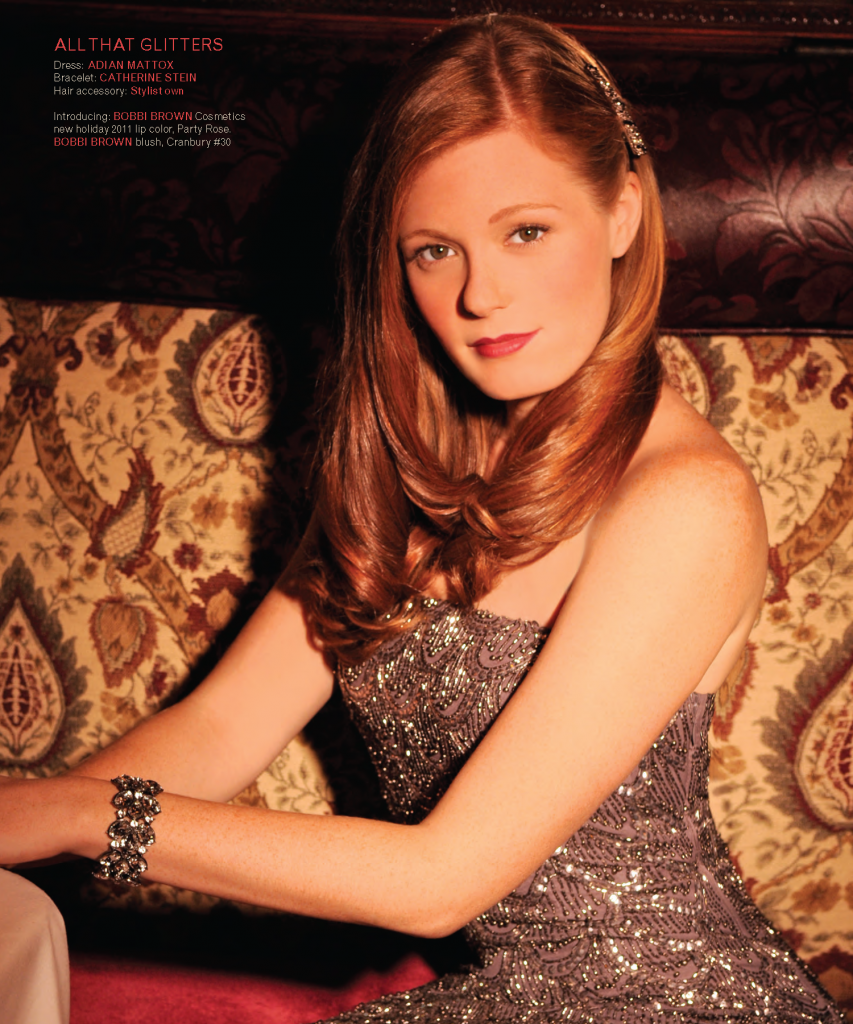


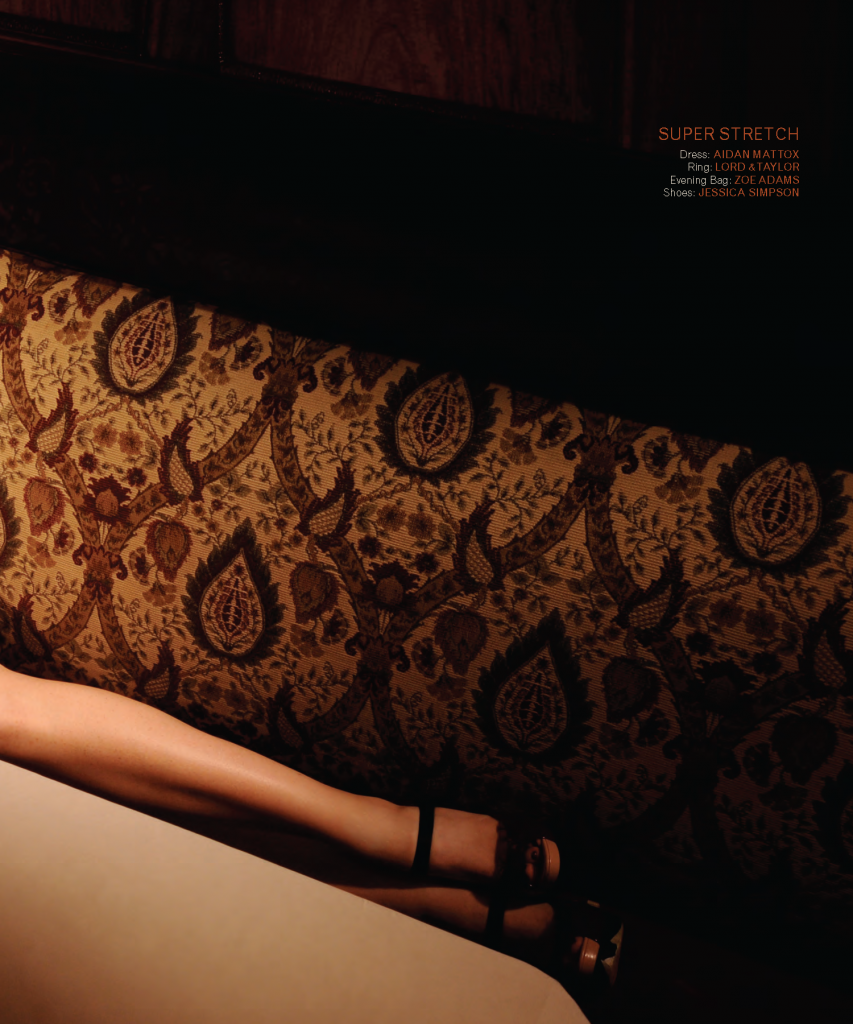
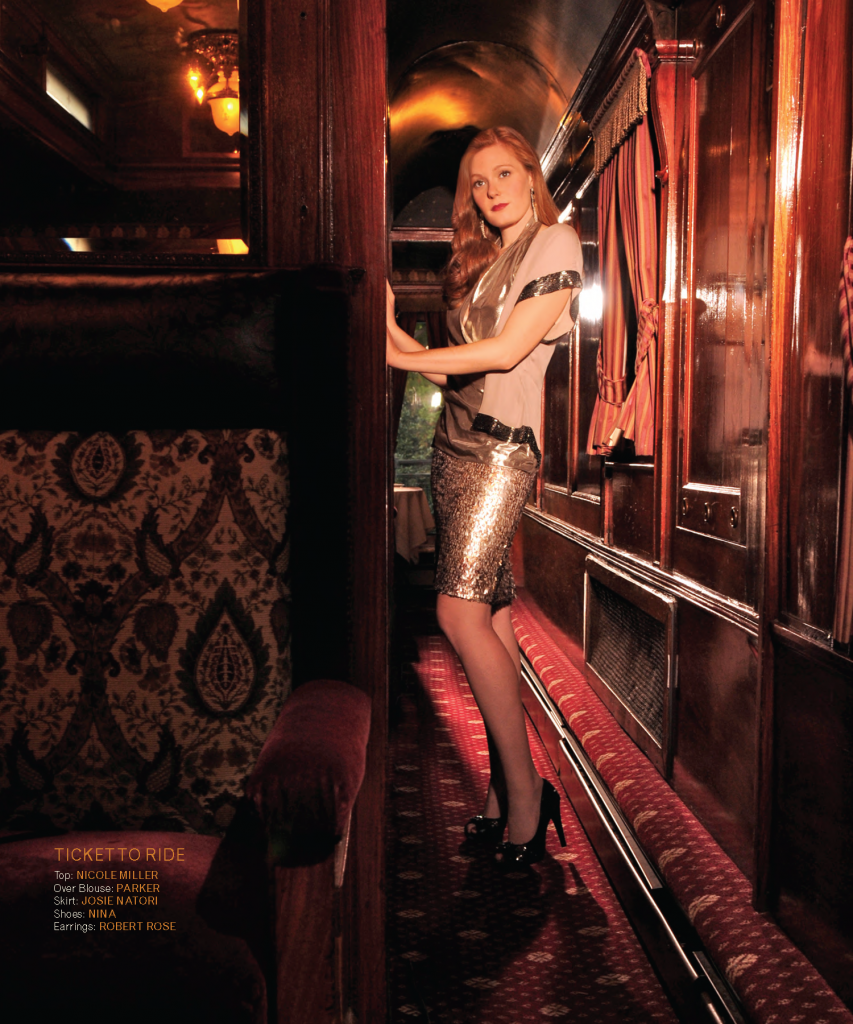

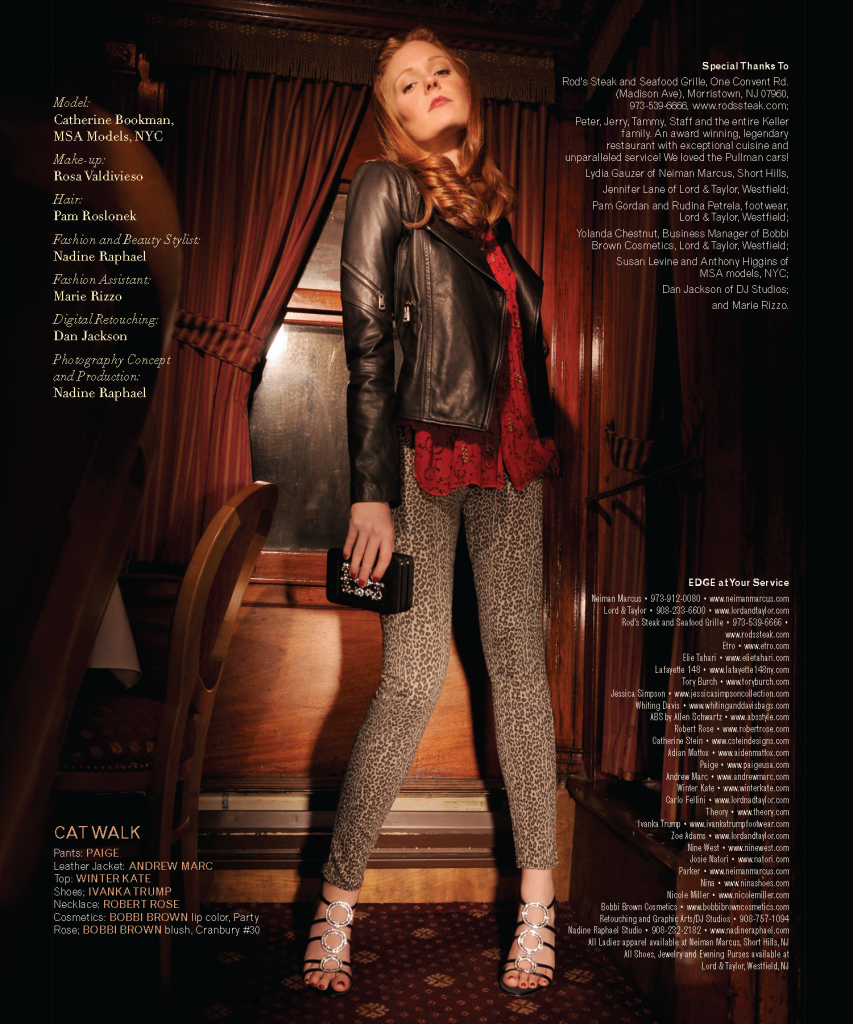
We Americans are a competitive breed. We go for the gold and shoot for the stars. Perhaps that’s why more than 50 million of us drop everything to tune into the Oscars, Emmys, Tonys & Golden Globes…and countless millions more follow the pre- and post-show activities on our TVs, iPads, laptops and smart phones. It certainly explains why New Jerseyans are particularly proud when “one of our own” takes the stage to grab a piece of that coveted hardware. Here’s a look at some Garden Staters who have taken Acting Out to award-winning extremes…
 The Envelope Please…
The Envelope Please…
Michael Douglas (b. 1944, New Brunswick) • Received his first Oscar in 1975 as Best Picture producer (One Flew Over the Cuckoo’s Nest). • Accepted the 1987 Best Actor Oscar as Gordon Gekko in Wall Street. • Won 3 Golden Globes (including one as producer of Romancing the Stone).
Linda Hunt (b. 1945 Morristown) • Won the 1983 Oscar for Best Supporting Actress for playing Billy Kwan in The Year of Living Dangerously, becoming the first person to win for portraying someone of the opposite sex.
Jack Nicholson (b. 1937 Neptune) • One of only three actors to win three Oscars (two for Best Actor in One Flew Over the Cuckoo’s Nest and As Good as It Gets and one for Best Supporting Actor in 1983 for Terms of Endearment). • Record holder for most nominations (8 for Best Actor and 4 for Best Supporting Actor).
Joe Pesci (b. 1943 Newark) • Won 1991 Best Supporting Oscar for Good Fellas. • Nominated 10 years earlier for Raging Bull.
Eva Marie Saint (b. 1924 Newark) • Won Best Supporting Oscar for On the Waterfront. • Received a Golden Globe nomination for her performance in A Hatful of Rain. • Won an Emmy for the mini-series People Like Us in 1990.
Frank Sinatra (b. 1915 Hoboken) • Won the 1954 Best Supporting Oscar as Maggio in From Here to Eternity and was nominated for Best Actor two years later as The Man with the Golden Arm. • A trio of Oscars for Best Original Song, and Golden Globe Best Actor wins for Pal Joey and Come Blow Your Horn. • Hosted the Academy Awards broadcast in 1963. • Awarded the Presidential Medal of Freedom by President Reagan in 1985.
Kevin Spacey (b. 1959 South Orange) • Won his first Oscar as Best Supporting Actor in 1996 for The Usual Suspects, and his second as Best Actor in American Beauty in 1999. • Artistic director of London’s Old Vic theatre since 2003.
Meryl Streep (b. 1949 Summit) • Nominated an astonishing 16 times (more than any other actor), winning it twice (for Kramer vs Kramer and Sophie’s Choice). • Received the most Golden Globe nominations (25 total, winning 7). • Earned a pair of Emmys and a Tony nomination, as well as the 2004 American Film Institute’s Lifetime Achievement Award.
John Travolta (b. 1954 Englewood) • Won a Golden Globe Award for Best Actor in Get Shorty. • Nominated for the Best Actor Oscar for Saturday Night Fever and Pulp Fiction.
 No Time Like Primetime…
No Time Like Primetime…
Danny DeVito (b. 1944 Neptune) • Won both the 1980 Golden Globe and 1981 Emmy as Louie De Palma on Taxi. • Earned an Oscar nomination as co-producer of Erin Brockovich in 2001.
Peter Dinklage (b. 1969 Morristown) • Won 2011 Best Supporting Emmy for HBO’s Game of Thrones.
John Forsythe (b. 1918 Penns Grove) • Nominated for Golden Globe six times, winning twice. • Emmy-nominated 4 times.
James Gandolfini (b. 1961 Westwood) • Won three Emmys as Tony in The Sopranos.
Ernie Kovacs (b. 1919 Trenton) • Received his only Emmy posthumously. • Emmy-nominated three times for The Ernie Kovacs Show.
Loretta Swit (b. 1937 Passaic) • Won a pair of Emmys as Hot Lips on M*A*S*H.
Jack Warden (b. 1920 Newark) • Won an Emmy for playing George Halas in Brian’s Song. • Oscar-nominated for Shampoo (1976) and Heaven Can Wait (1979).
 Curtain Call
Curtain Call
Jason Alexander (b. 1959 Newark) • Won a Tony pre-Seinfeld for his appearance in Jerome Robbins Broadway in 1989. • Earned Emmy nominations each year from 1992 to 1998.
Nikki James (b. 1951 Summit) • Won a 2011 Tony as Best Featured Actress in a Musical for The Book of Mormon.
Jane Krakowski (b. 1968 Parsippany) • Nominated for a 1990 Tony for Grand Hotel and won in 2003 for her performance in Nine. • Nominated for Emmys 2009–2011 for 30 Rock.
Phyllis Newman (b. 1933 Jersey City) • Edged out Barbra Streisand for the 1961 Tony for her role in Subways are for Sleeping.
Some Very Honorable Mentions These New Jerseyans made huge contributions on stage, screen and television but were overlooked when it came time to pass out the serious hardware…
Bud Abbott (b. Asbury Park 1895)
Lou Costello (b 1906 Paterson)
Jerry Lewis (b. 1926 Newark)
Judith Light (b. 1949 Trenton)
Ozzie Nelson (b. 1906 Jersey City)
Unmentionable • The cast of MTV’s Jersey Shore. • Anyone who watches it.
Vincent Pastore is a hard man to pin down. His interests are many, his gears constantly turning, his attention often divided. Tracey Smith chased him all summer for this interview, hoping to capture the essence of a show business Renaissance Man. To her delight, Pastore turned out to be that Renaissance Man in every conceivable way. Indeed, one can easily imagine him perched upon the throne of a 16th century city-state…or transforming a block of marble into a masterpiece for a wealthy patron…or dodging the business end of an enemy lance at the vanguard of an attacking army. From his tour de force as the conflicted criminal underboss Salvatore “Big Pussy” Bonpinsiero on The Sopranos to his unforgettable stints on reality TV, Pastore has become one of the most cherished characters—and character actors—of our time.
EDGE: The bad guys on The Sopranos could be warm and vulnerable and then suddenly turn and become cold, heartless killers. Your character had the added dimension of being deeply conflicted about being an informant. Did you enjoy that extra challenge?
VP: I did. David Chase wrote that role for an actor who could play a tough guy who also could be sensitive. I saw Big Pussy as a man with a big heart, and that was my choice of how I played that role. In that scene where he is crying in the bathroom at Anthony Jr.’s confirmation, you knew it was not just because he was a rat—he was betraying his friends, which was even harder to deal with.
EDGE: Was Big Pussy the most subtly textured character you have played in your career?
VP: Hmm, that’s a tough question. Probably. Going through so much mental turmoil over such a long period of time, dealing with the tension of if and when he was ever going to get caught by his friends for being an informant. I can tell you that it stayed with me as an actor, over five days a week of taping. It was rather tough.
EDGE: In addition to your acting, you are involved with a lot of plays.
VP: I try to produce three plays a year. It really enables people to see the actors work. I started doing this four years ago. It’s enabled me to continue working with several actors from The Sopranos, including Maureen Van Zandt, Nicholas Giangiulio, Joe Lisi, Garry Pastore, Tony Rossi, Anthony Ribustello and Janet Sarno. I don’t make a lot of money because I own the theater company, but we’ve had a pretty good run.
EDGE: Is that a different kind of stressful?
VP: Yes. The behind-the-scenes aspects of theater can be very stressful. I recently co-produced the revival of Lamp Post Reunion by Hoboken playwright Louis LaRusso. Danny Aiello played the lead character. There were frequent worries about who was ready or on cue. Plus the mood of the main character was dark.
EDGE: Your television and film roles are typically big, rich characters. How much of what we see on screen is you, and how much of that is you slipping into character?
VP: That depends on the role. I am currently being filmed as a mayor in Surviving Family and I’m not acting like the typical wiseguy that I’ve played in the past, like Angelo Ruggiero from Gotti or Big Pussy from The Sopranos. In Surviving Family I am acting, whereas those other characters are closer to who I am. I am Angelo. I am Big Pussy. And trust me, playing a mayor is a whole lot different than playing a wiseguy. There’s no comparison.
EDGE: What about the over-the-top Vincent Pastore we’ve sometimes seen on reality television shows, like Famous Food, The Apprentice and Celebrity Fit Club?
VP: What reality producers try to do is put me up against certain situations to bring out the best or worst in me, which is what the reality television mission is, in all actuality. They place you in a bad improvisation scene with someone you genuinely don’t like, and you’re forced to work with them. They want drama, emotion and conflict. Sometimes my temper shows, but I believe that as long as you don’t take it home to your family, and keep it out of your personal life, it’s okay.
EDGE: You pointed out in a previous issue of this magazine that not everyone can play a wiseguy. By the same token, no two wiseguys are alike. Big Pussy was a fictional character. But the part you played in Gotti was not. What was the challenge in interpreting that role?
VP: Angelo Ruggiero was a real person, so it was key to know the relationship between the two men. John and Angelo had a priceless bond. Armand Assante, who played Gotti, told me that the song The Wind Beneath My Wings reminded him of Ruggiero. He was always right behind John Gotti. He was loyal, and he never ratted. So you have to do the research, know the character. It’s true—not everyone can do this, not everybody can play a wiseguy.
EDGE: You mentioned that Angelo Ruggiero and Big Pussy are “you.” How often do you reach back and draw on your experiences outside the theater, to the real-life characters you’ve known, when you play a part?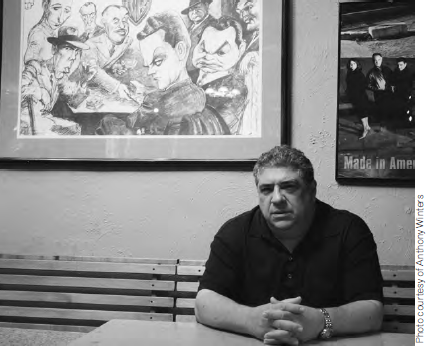
VP: A lot of people think I grew up with those kinds of people. The truth is that I grew up in a pure Italian-American home. Tradition. We lived in New Rochelle in an Italian neighborhood. I can still smell the pizza! Roller skating every Friday night at the Boys Club. Great memories. We saw bookies and loan sharks. But to play these roles you don’t rely on memories. You use your own personality and come up with a great character. And for the record, I never knew any rats.
EDGE: Your family lived above a social club.
VP: The Forester’s Club of America. It’s still there. When I was a kid, I packed the cases of beer, cleaned up after the card games. I still can remember the smell of the stinky ashtrays—which probably had an influence on me later owning a bar. Most days I would get there at 3:00. My dad was a school custodian. He’d get back around 6:00. My mom cooked for the men at the bar on the weekend. There was a big hall in the basement where they would play team games and card games. There was an annual picnic, a Christmas party. A lot of meetings took place here.
EDGE: Sounds like a typical Italian-American social club.
VP: Yes, but not like a John Gotti “social club.”
EDGE: Is it true that you got into acting through Matt and Kevin Dillon?
VP: It was really Kevin Dillon who got me my first break. I used to drive a limo in New York and that’s when I met the brothers for the first time. I told them about my dreams of becoming an actor. They ended up seeing me at this community theater I was doing, and Kevin helped me out. He gave me the direction I needed to finally act. From there, Danny Aiello really became my mentor.
EDGE: One last Sopranos question. Your partner in crime, Pauly Walnuts, went from one line in the first episode to mob superstardom. How did that go down?
VP: The Sopranos was my dear friend Tony Sirico’s last hurrah. He had been in the business for twenty years, had come up through the ranks of indie films, and he had to make an impact. He had to get physically and spiritually more space. In the pilot his one line was Barone wants to talk to you. My part was much bigger. David Chase liked Paulie Walnuts, so he made Tony a technical assistant, and eventually wrote him in more and more.
EDGE: What was it like sharing a scene with a character like Paulie Walnuts?
VP: Like sharing a camera with an elephant! He wanted the whole camera, (laughing) but he let me squeeze in there from time to time. Tony was so experienced. I respect him so much. He always came to work prepared, ready, knew his lines, make-up was perfect. I truly learned from him.
EDGE: Is there a brass-ring role that’s out there for you? Is there a character you were born to play?
VP: I’d love to be on a sitcom. I’d love to finally play someone warm and funny.
Editor’s Note: Tracey Smith is a freelance writer who lives in Chicago. She is working on a book about contemporary films on gangsters and organized crime.
’Tis the season. No, not of family gatherings and holiday cheer. For college-bound seniors and their parents, it’s crunch time.
College admissions officers are bracing themselves for the tsunami. Over the next few weeks, the steady stream of applications they have been wading through will turn into an unstoppable torrent. One of the countless charms of the Internet is that it has made the process of applying to multiple schools incredibly simple. A generation ago, high-school seniors would pick a handful of schools—including a reach and a safety—fill out the paperwork by hand, lick the envelope, stamp it, and send it off. Thanks to the common application (aka The Common App) and the wonders of technology, today every one of the 3.5 million teenagers thinking about college can apply to 20 schools with only slightly more effort than it took to lick those envelopes. One thing about teenagers hasn’t changed. No matter how easy the computer has made it for them to apply to college, they somehow find a way to turn the process into a full-on heart attack anyway. The majority of kids will be pushing the SEND button on their applications just a day or two before the deadline. Some will take it down to the final minutes or seconds. While frustrating for parents, engaging in this type of brinksmanship isn’t what should concern the moms and dads of college-bound seniors. The critical time-management issue is making sure that enough thought and effort have been devoted to the creation of an essay for the common application that grabs the attention of even the most overwrought admissions officer. It is the piece that tells a college who a young person is, and helps determine whether he or she would be a good fit for the school. Is your senior‘s essay done? I’m guessing the answer is no. Remove your fingers from around your child’s neck for a moment and take a look at what another kid did. I asked four professionals in the college admissions process to critique this essay. I made it clear that the writer had already matriculated, so we weren’t fishing for praise. Instead, we were looking for specific, constructive criticism that would help members of the Class of 2013 evaluate their college essays as the application deadline nears….
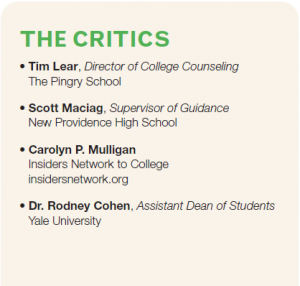
THE ESSAY When life hits you in the face, react with your head, not your hands. I never really knew what my parents were talking about until that awful Sunday afternoon in May. I had struck a section of guardrail with such force, and at such an unusual angle, that it lifted two of the supporting stanchions completely out of the ground. Luckily, I was unhurt. The culprit was long gone. Not a drunk driver. Not some idiot wolfing down a Quarter Pounder while texting on his cell phone. Rather, it was an enormous beetle that had flown through the open, driver-side window—smack into my face. A novice behind the wheel, I swerved left, over-corrected right, and finally lost control at 50 miles per hour. Precisely six weeks after posing for my first driver’s license photo, I had become a cliché. I was shocked and angry and embarrassed. The car was a twisted wreck. It had collapsed around me, absorbing the energy of my high-speed, metal-on-metal encounter. Totaled. It was only later, when I saw photos of the car and revisited the scene of the accident, that I realized how fortunate I was. Had I swerved 20 feet sooner I might have been cleaved by a telephone pole. Had I left the road 20 feet farther down the hill, I would have launched myself into a ravine. Teenagers are not wired to contemplate their own demise, yet whenever I drive past this spot it is hard to think of anything else. In time I realized something slightly more profound. By handing the keys to a newly minted driver, mom and dad were giving me that first terrifying (for them) taste of true independence that’s part of the letting-go process of parenthood. While all I saw was the upside, they had quietly thought through the downside and purchased the automotive equivalent of a Panzer—a used Audi wagon that was basically conceived and constructed to crash into guard rails and deliver young drivers back to their parents older, wiser and relatively unscathed. I might mention here that I had lobbied briefly for a Thunderbird convertible (yeah, dream on!). It’s less than a year later and my parents are now preparing to hand me the keys to a college education. They will be writing out another large, painful check and making me the driver of my own life. How terrifying this is for them I can only guess. Recently, I found myself telling a friend “when life hits you in the face, react with your head, not your hands.” She wasn’t really sure what I was talking about, but a few weeks later, she found herself wrapped around a telephone pole thanks to an adventurous squirrel. At this point, it is safe to say that almost everyone in our group of friends has both heard and understood this bit of wisdom. Of course, part of giving advice is accepting that advice yourself. And in that spirit, I would like to tell my parents what I have learned. Next time I will react with my head and not my hands. That’s a no-brainer, so to speak. And although I still feel indestructible, I also know grave consequences await both my actions and in-actions. Mostly what I’d like to tell them is that in choosing a college, I now know I’m looking for the Audi, not the T-bird. I’d like to tell them…but I won’t. As they taught me, sometimes you just have to figure things out for yourself.
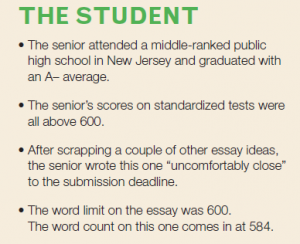
THE FEEDBACK All four of our experts agreed on two things. The essay demonstrated excellent writing skills, but also fell short of that certain something admissions officers love to see in an essay: Wow Factor. “I really enjoyed the opening. It grabbed my attention and piqued my curiosity,” says Lear. However, he  maintains that the subject matter was potentially risky, as some colleges might view the author as “a rather spoiled, a suburban poet without any real wisdom to impart.” “While good writing is good writing, period,” Lear explains, “students need to tell a good story and try to exhibit some real depth. Introspection is an underrated trait, and students are often quick to wrap up their essays too simply or neatly. Embracing ambiguity and thinking deeply before writing are two tips I would offer seniors.” “I thought it was well written, but it ultimately left me scratching my head,” says Cohen, who wanted to know more about the student than was revealed in the essay. “It didn’t tell me enough about the writer as a person. He/she spent entirely too much time on the accident. Ultimately schools are looking for Who are you? How are you going to fit in?” “I like the line about the ‘grave consequences await both my actions and inactions,’’ says Maciag. “This line can send a powerful message. I feel a more substantive essay could have come out of this line than ‘reacting with my head not my hands.’” An essay is supposed to tell the admissions committee something about yourself that is not revealed in the application, Maciag points out. “I did not get this from the essay. I felt the essay included too many details about the accident that had no bearing on the lesson learned.” Mulligan points out that the essay does achieve something critically important. “It was engaging from the start,” she says. “The subject matter caught my attention and kept me reading to find out how it all ended. In the days when admissions folks are reading
maintains that the subject matter was potentially risky, as some colleges might view the author as “a rather spoiled, a suburban poet without any real wisdom to impart.” “While good writing is good writing, period,” Lear explains, “students need to tell a good story and try to exhibit some real depth. Introspection is an underrated trait, and students are often quick to wrap up their essays too simply or neatly. Embracing ambiguity and thinking deeply before writing are two tips I would offer seniors.” “I thought it was well written, but it ultimately left me scratching my head,” says Cohen, who wanted to know more about the student than was revealed in the essay. “It didn’t tell me enough about the writer as a person. He/she spent entirely too much time on the accident. Ultimately schools are looking for Who are you? How are you going to fit in?” “I like the line about the ‘grave consequences await both my actions and inactions,’’ says Maciag. “This line can send a powerful message. I feel a more substantive essay could have come out of this line than ‘reacting with my head not my hands.’” An essay is supposed to tell the admissions committee something about yourself that is not revealed in the application, Maciag points out. “I did not get this from the essay. I felt the essay included too many details about the accident that had no bearing on the lesson learned.” Mulligan points out that the essay does achieve something critically important. “It was engaging from the start,” she says. “The subject matter caught my attention and kept me reading to find out how it all ended. In the days when admissions folks are reading  thousands of essays this is so important—to keep eyes from glazing over and hold the attention of the reader. For the most part, he or she is a solid writer with a terrific vocabulary and good writing style. The essay puts the student in an interesting story, which I like.” When asked if the essay would be better for one type of school over another, Mulligan pointed out that this actually should not be a consideration for the main essay. “Students are attempting to tell the schools who they are,” she explains. “This is their big chance—often the only forum. It is not like Cinderella and the glass slipper, I tell my students. You are not trying to fit yourself into a school, or gear an essay to a school. You are trying to see if a school fits you, and so the essay is about you…and you should not change it to fit different tiers of schools.” To the What type of school… question, Lear had a more succinct response: “One that doesn’t allow freshmen to drive cars.”
thousands of essays this is so important—to keep eyes from glazing over and hold the attention of the reader. For the most part, he or she is a solid writer with a terrific vocabulary and good writing style. The essay puts the student in an interesting story, which I like.” When asked if the essay would be better for one type of school over another, Mulligan pointed out that this actually should not be a consideration for the main essay. “Students are attempting to tell the schools who they are,” she explains. “This is their big chance—often the only forum. It is not like Cinderella and the glass slipper, I tell my students. You are not trying to fit yourself into a school, or gear an essay to a school. You are trying to see if a school fits you, and so the essay is about you…and you should not change it to fit different tiers of schools.” To the What type of school… question, Lear had a more succinct response: “One that doesn’t allow freshmen to drive cars.”
Editor’s Note: Assignments Editor Zack Burgess writes on culture, politics and sports for a number of publications and web sites. His work can be seen on zackburgess.com. The young author of the essay in this story was accepted by (and now attends) a Top 30 university.


